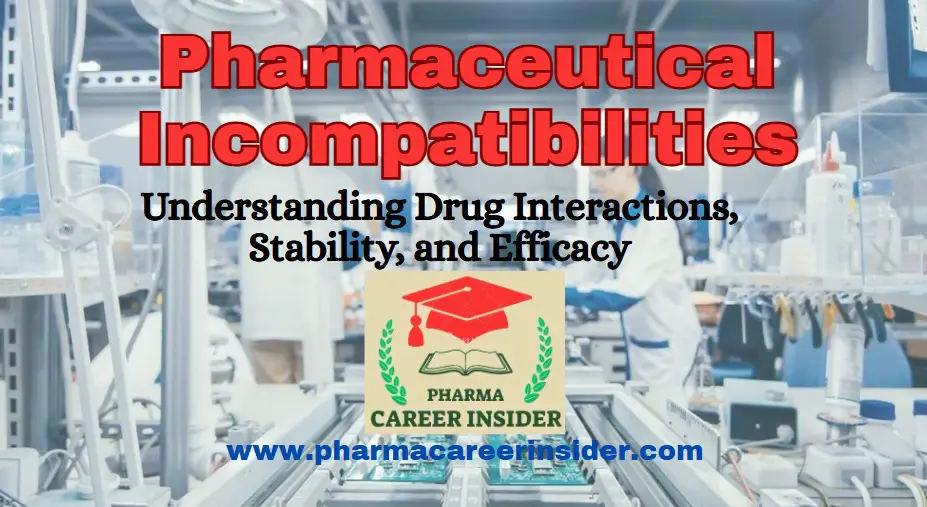Why Pharmaceutical Incompatibilities Matter
Pharmaceutical incompatibilities are a serious drug formulation, compounding, and administration issue. They can lead to loss of therapeutic efficacy, increased toxicity, and adverse drug reactions. In worst-case scenarios, incompatibilities can result in life-threatening complications for patients.
Healthcare professionals, including pharmacists, nurses, and doctors, must recognize and mitigate these incompatibilities to ensure safe and effective patient care. Understanding the types, causes, and preventive measures is crucial for optimizing drug therapy outcomes.
The Consequences of Ignoring Pharmaceutical Incompatibilities
Failure to address pharmaceutical incompatibilities can lead to severe consequences:
- Therapeutic Failure: Some incompatibilities lead to loss of drug potency, reducing the intended pharmacological effect. For example, improperly mixing insulin with certain IV fluids can render it ineffective.
- Toxicity and Side Effects: Some drug combinations result in increased toxicity. A well-documented case involves calcium and ceftriaxone precipitation in neonates, leading to fatal embolism.
- Physical Changes: Certain drugs crystallize, precipitate, or discolor when mixed incorrectly, making them unsuitable for administration.
- Economic Losses: Pharmaceutical wastage due to incompatibilities leads to financial losses for hospitals and pharmacies.
Despite stringent quality control, real-world errors still occur. A study published in the Journal of Pharmaceutical Sciences found that 34% of IV drug preparations showed evidence of physical or chemical incompatibility due to incorrect dilution or co-administration.
Understanding Types, Causes, and Prevention of Pharmaceutical Incompatibilities
To prevent these complications, professionals need to classify, identify, and mitigate different types of pharmaceutical incompatibilities. Let’s break them down in detail.
1. Types of Pharmaceutical Incompatibilities
Pharmaceutical incompatibilities are broadly classified into three categories: physical, chemical, and therapeutic.
a) Physical Incompatibilities
Physical incompatibilities occur when visible changes such as precipitation, turbidity, or color change arise due to improper drug combination.
Examples:
- Calcium and Phosphate in IV Fluids: When combined in excessive concentrations, these form an insoluble precipitate.
- Amphotericin B and Electrolyte Solutions: This antifungal drug precipitates in electrolyte-rich fluids.
- Diazepam in Aqueous Solutions: Diazepam requires a non-aqueous solvent and precipitates in water-based solutions.
Prevention Strategies:
- Use compatible diluents and solvents.
- Follow recommended concentrations and infusion rates.
- Store and handle drugs under appropriate conditions.
b) Chemical Incompatibilities
Chemical incompatibilities occur due to molecular reactions between drug components, leading to loss of potency or formation of toxic byproducts.
Examples:
- Ascorbic Acid and Aminophylline: Oxidation of ascorbic acid reduces its efficacy.
- Penicillin and Aminoglycosides: These antibiotics inactivate each other when mixed.
- Nitroglycerin and PVC Containers: Nitroglycerin adsorbs onto plastic surfaces, reducing the intended dose.
Prevention Strategies:
- Avoid co-administration of chemically incompatible drugs.
- Use appropriate containers (e.g., glass vials for nitroglycerin instead of plastic).
- Maintain pH and temperature conditions as recommended.
c) Therapeutic Incompatibilities
Therapeutic incompatibilities arise when two drugs interact pharmacodynamically or pharmacokinetically, leading to undesirable effects.
Examples:
- Warfarin and NSAIDs: Increased risk of bleeding due to synergistic anticoagulant effects.
- ACE Inhibitors and Potassium-Sparing Diuretics: Risk of hyperkalemia.
- Fluoroquinolones and Antacids: Reduced fluoroquinolone absorption due to chelation with aluminum or magnesium.
Prevention Strategies:
- Conduct thorough medication reconciliation before prescribing.
- Schedule doses to avoid overlapping effects (e.g., taking antacids and fluoroquinolones hours apart).
- Monitor patient parameters regularly (e.g., INR for warfarin users).
2. Causes of Pharmaceutical Incompatibilities
Several factors contribute to incompatibilities, including:
- pH Differences: Drugs with significantly different pH levels can precipitate or degrade when mixed.
- Solubility Issues: Some drugs require specific solvents and precipitate when diluted incorrectly.
- Light Sensitivity: Drugs like nitroprusside degrade when exposed to light.
- Temperature Variations: Freezing or excessive heat can alter drug stability.
- Order of Mixing: Some drugs require a specific mixing sequence to prevent precipitation.
3. Prevention of Pharmaceutical Incompatibilities
Preventing incompatibilities requires a multi-faceted approach involving healthcare professionals and patients.
For pharmacists:
- Cross-check compatibility charts before preparing IV admixtures.
- Label medications with appropriate storage and administration instructions.
- Use automated drug interaction software to flag potential issues.
For Nurses & Doctors:
- Follow correct dilution and administration guidelines.
- Avoid Y-site mixing of IV drugs unless verified as compatible.
- Communicate with pharmacists before making changes in therapy.
For Patients & Caregivers:
- Avoid self-medicating with multiple drugs without professional consultation.
- Follow administration instructions, especially with food-drug interactions.
- Report any adverse effects or unexpected changes in medication appearance.
Conclusion
Pharmaceutical incompatibilities pose significant risks, but with careful awareness and adherence to best practices, they can be effectively prevented. By understanding the different types, recognizing their causes, and implementing preventive strategies, healthcare professionals can ensure patient safety and optimize therapeutic outcomes.
Ignoring pharmaceutical incompatibilities is not an option. Every stakeholder in the healthcare system must play a role in preventing these risks, from pharmacists verifying formulations to patients following prescription guidelines correctly. With diligence and the right knowledge, we can minimize errors and improve drug efficacy for better health outcomes.
Frequently Asked Questions (FAQs)
1. What are pharmaceutical incompatibilities?
Answer: Pharmaceutical incompatibilities occur when two or more drugs interact physically, chemically, or therapeutically, leading to reduced efficacy or harmful effects.
2. What is an example of chemical incompatibility in pharmacy?
Answer: A classic example is the combination of penicillin and aminoglycosides, which inactivates both drugs when mixed.
3. How can we prevent drug incompatibilities in hospitals?
Answer: Prevention involves using compatibility charts and automated drug interaction software and following strict dilution and administration guidelines.
4. Why do some IV drugs precipitate when mixed?
Answer: Precipitation occurs due to differences in pH, solubility issues, or improper order of mixing.
5. What is the difference between physical and chemical incompatibility?
Answer: Physical incompatibility results in visible changes (precipitation, turbidity), while chemical incompatibility leads to molecular changes affecting drug stability and potency.




V nice
Good information sir 👍